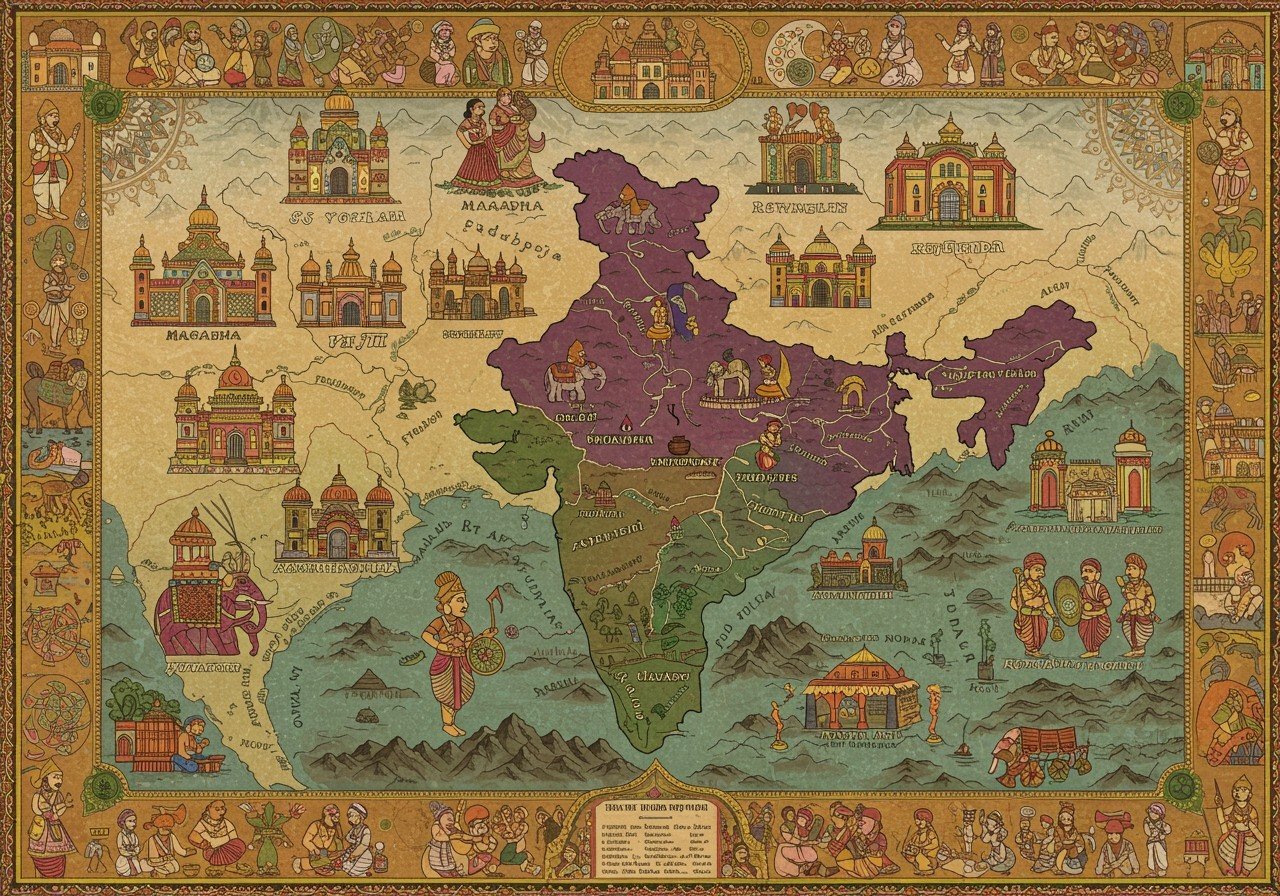
Delve into the fascinating history of ancient India by learning about the sixteen Mahajanapadas, the significant republics that thrived across the Indian subcontinent around the 6th century BCE to the 4th century BCE. Discover their cultural, political, and economic importance. Understand their unique forms of governance and their lasting influence on Indian history.
Origins and Definition of Mahajanapadas
Mahajanapadas translates to ‘great realms’ or ‘great republics’. These states emerged during the Later Vedic period, evolving from smaller tribal states due to factors like economic growth and political consolidation. They played a vital role in shaping ancient India’s socio-political landscape.
The Sixteen Mahajanapadas
Here’s a list of the sixteen prominent Mahajanapadas:
- Anga
- Assaka
- Avanti
- Chedi
- Gandhara
- Kamboja
- Kasi
- Kosala
- Kuru
- Magadha
- Malla
- Matsya
- Panchala
- Surasena
- Vajji
- Vatsa
Each state had its own capital and contributed uniquely to political power, economic prosperity, and cultural development.
Mahajanapadas and Their Capitals
The capitals were strategically located, often along trade routes or near rivers, influencing their growth and interactions with neighboring states. This geographical positioning played a key role in their development.
Political Structure and Governance
The Mahajanapadas exhibited a variety of governance structures. Some were monarchies with centralized power under a king, like Magadha. Others, such as Vajji and Malla, were republics where governance was conducted through assemblies and councils with elected officials. This period witnessed the development of both republics and monarchies in North India.
Economic and Trade Significance
Agriculture, trade, and craftsmanship formed the economic backbone of the Mahajanapadas. Established trade routes connected these states, facilitating prosperity and cultural exchange. Commodities like textiles, spices, and metals were traded across India and beyond.
Cultural Contributions
The Mahajanapadas significantly advanced art, literature, and architecture, influencing Indian philosophy, religion, and education. Their notable landmarks and literary works continue to inspire today.
Decline and Fall of the Mahajanapadas
Internal conflicts, external invasions, and the rise of powerful empires like Magadha contributed to the decline of the Mahajanapadas. This marked a transition to larger empires in the political landscape of ancient India.
Poojn.in: Connecting You to Ancient Indian Heritage
Poojn.in, India’s largest cultural goods & services store, offers a wide selection of products that connect you to the rich heritage of the Mahajanapadas. We provide:
- Authentic puja items crafted by traditional artisans, reflecting the craftsmanship of ancient kingdoms.
- Items range from pure copper and brass pieces reminiscent of Magadha and Kashi to earthen lamps (diyas) similar to those used in ancient Vajji and Malla.
- Sacred threads (janeu) and ritual clothing, preserving customs practiced since the Mahajanapada era.
- Poojn.in offers a convenient online shopping experience with quality-checked items delivered to your doorstep across India, ensuring you receive products that meet traditional standards.
Explore our collection at www.poojn.in and experience the spiritual legacy of ancient India. Consider these relevant products:
Conclusion
The sixteen Mahajanapadas provide a glimpse into ancient India’s rich and diverse history. These republics and monarchies were cultural and economic centers that laid the groundwork for future civilizations. Their unique governance, strategic capitals, and vibrant trade networks fostered prosperity and cultural growth. While they eventually declined, their legacy continues to shape India’s socio-political landscape and inspire through their contributions to art, literature, and philosophy.
FAQs on Sixteen Mahajanapadas
What were the Sixteen Mahajanapadas? The Sixteen Mahajanapadas were ancient Indian kingdoms or republics that flourished around the 6th century BCE. They marked a crucial stage in the development of states in North India.
What is their significance? They represent the early development of statehood in ancient India, paving the way for later political and social structures. The Mahajanapadas provide valuable insights into ancient Indian governance, economy, and culture.
How did they rise to power? Their rise stemmed from a combination of military strength, economic prosperity, and strategic alliances. They established robust systems of governance that enabled them to thrive.
Why did they decline? Their decline can be attributed to a combination of internal conflicts, external invasions, and the rise of larger, more centralized empires like the Maurya Empire. Many of these smaller kingdoms and republics were eventually absorbed into these larger empires.
You can explore more about ancient Indian history and culture through resources like history textbooks, online educational platforms, and museums. These resources often provide maps, timelines, and detailed information about the Mahajanapadas, their capitals, and their influence on India’s rich past.
For a deeper understanding of the spiritual and cultural practices of ancient India, visit Sanskrit Mantras: A Spiritual Language Guide and Prasad Recipes: A Guide to Significance and Taste.


